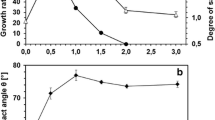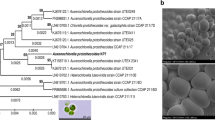Abstract
In general, members of Rhodococcus genus are highly resistant to desiccation. Desiccation is a complex process which includes the formation of reactive oxygen species that results in significant damage to cells. In this study, we demonstrate that extremophile actinobacterial strains isolated from diverse environments, mainly belonging to Rhodococcus genus, exhibited high tolerance to the pro-oxidants hydrogen peroxide (H2O2) and methyl viologen (MV). In addition, we investigated the possible interconnections between the responses of the oleaginous Rhodococcus opacus PD630 to oxidative stress and lipid metabolism, since both processes demand a metabolic reorganization of cells. Experiments with metabolic inhibitors showed differential effects of both pro-oxidants on lipid metabolism in PD630 cells. The inhibition of carotenoid biosynthesis by the addition of diphenylamine to the media negatively affected the tolerance of cells to H2O2, but not to MV. The inhibition of triacylglycerol (TAG) biosynthesis and accumulation in PD630 did not affect the tolerance of cells to H2O2 and MV; whereas, the blockage of lipolysis decreased the tolerance of cells to H2O2 (but not MV) under carbon-starvation conditions. Interestingly, the addition of MV to the media (but not H2O2) induced a reduction of TAG accumulation by cells. Resuming, results of this study revealed metabolic connections between lipid metabolism and oxidative stress responses in R. opacus PD630, and probably in other extremophile TAG-accumulating rhodococci.






Similar content being viewed by others
References
Alvarez HM, Steinbüchel A (2010) Physiology, biochemistry and molecular biology of triacylglycerol accumulation by Rhodococcus. In: Alvarez HM (ed) Biology of Rhodococcus. Microbiology monographs series. Springer Verlag, Heidelberg, pp 263–290
Alvarez HM, Mayer F, Fabritius D, Steinbüchel A (1996) Formation of intracytoplasmic lipid inclusion by Rhodococcus opacus PD630. Arch Microbiol 165:377–386
Alvarez HM, Kalscheuer R, Steinbüchel A (1997) Accumulation of storage lipids in species of Rhodococcus and Nocardia and effect of inhibitors and polyethylene glycol. Fett/Lipid 99:239–246
Alvarez HM, Kalscheuer R, Steinbüchel A (2000) Accumulation and mobilization of storage lipids by Rhodococcus opacus PD630 and Rhodococcus ruber NCIMB 40126. App Microbiol and Biotechnol 54:218–223
Alvarez HM, Silva RA, Cesari AC, Zamit AL, Peressutti SR, Reichelt R, Keller U, Malkus U, Rasch C, Maskow T, Mayer F, Steinbüchel A (2004) Physiological and morphological responses of the soil bacterium Rhodococcus opacus strain PD630 to water stress. FEMS Microbiol Ecol 50:75–86
Beauchamp C, Fridovich I (1971) Superoxide dismutase: improved assays and an assay applicable to acrylamide gels. Anal Biochem 44:276–287
Bequer Urbano S, Albarracín VH, Ordoñez OF, Farías ME, Alvarez HM (2013) Lipid storage in high-altitude Andean Lakes extremophiles and its mobilization under stress conditions in Rhodococcus sp. A5, a UV-resistant actinobacterium. Extremophiles 17:217–227
Bhatnagar A, Bhatnagar M (2005) Microbial diversity in desert ecosystem. Curr Sci 89:91–100
Bradford MM (1976) A rapid and sensitive method for the quantitation of microgram quantities of protein utilizing the principle of protein–dye binding. Anal Biochem 72:248–254
Brumaghim JL, Li Y, Henle E, Linn S (2003) Effects of hydrogen peroxide upon nicotinamide nucleotide metabolism in Escherichia coli: changes in enzyme levels and nicotinamide nucleotide pools and studies of the oxidation of NAD(P)H by Fe(III). J Biol Chem 278:42495–42504
Burchell MJ, Mann JR, Bunch AW (2004) Survival of bacteria and spores under extreme shock pressure. Mon Not R Astron Soc 352:1273–1278
Clement M, Watson S, Foster S (1999) Characterization of the major superoxide dismutase of Staphylococcus aureus and its role in starvation survival, stress resistance, and pathogenicity. J Bacteriol 181:3898–3903
Connon S, Lester E, Shafaat H, Obenhuber D, Ponce A (2007) Bacterial diversity in hyperarid Atacama Desert soils. J Geophys Res 112:1–9
Contreras-Porcia L, Thomas D, Flores V, Correa JA (2011) Tolerance to oxidative stress induced by desiccation in Porphya columbina (Bangiales, Rhodophyta). J Exp Bot 62:1815–1829
Di Capua C, Bortolotti A, Farías ME, Cortez N (2011) Ultraviolet-resistant Acinetobacter sp. isolates from Andean Wetlands display high catalase activity. FEMS Microbiol Lett 317:181–189
Donahue JL, Okpodu CM, Cramer CL, Grabau EA, Alscher RG (1997) Response of antioxidants to paraquat in pea leaves (relationships to resistance). Plant Physiol 113:249–257
França MB, Panek AD, Eleutherio ECA (2005) The role of cytoplasmic catalase in dehydration tolerance of Saccharomyces cerevisiae. Cell Stress Chaperones 17:167–170
França MB, Panek AD, Eleutherio ECA (2007) Oxidative stress and its effects during dehydration. Comp Biochem Physiol A: Mol Integr Physiol 146:621–631
Ghosal D, Omelchenko MV, Gaidamakova EK, Matrosova VY, Vasilenko A, Venkateswaran A, Zhai M, Kostandarithes HM, Brim H, Makarova KS, Wackett LP, Fredickson JK, Daly MJ (2005) How radiation kills cells: survival of Deinococcus radiocurans and Shewanella oneidensis under oxidative stress. FEMS Microbiol Rev 29:361–375
Hassan HM, Fridovich I (1978) Superoxide radical and the oxygen enhancement of the toxicity of paraquat in Escherichia coli. J Biol Chem 253:8143–8148
Hassan HM, Fridovich I (1979) Paraquat and Escherichia coli Mechanism of production of extracellular superoxide radical. J Biol Chem 254:10846–10852
Heald SC, Brandão PF, Hardicre R, Bull AT (2001) Physiology, biochemistry and taxonomy of deep-sea nitrile metabolising Rhodococcus strains. Antonie Van Leeuwenhoek 80:169–183
Hernández MA, Alvarez HM (2010) Glycogen formation by Rhodococcus species and the effect of inhibition of lipid biosynthesis on glycogen accumulation in Rhodococcus opacus PD630. FEMS Microbiol Lett 312:93–99
Hernández MA, Mohn WW, Martínez E, Rost E, Alvarez AF, Alvarez HM (2008) Biosynthesis of storage compounds by Rhodococcus jostii RHA1 and global identification of genes involved in their metabolism. BMC Genom 12(9):600
Imlay J (2003) Pathways of oxidative damage. Annu Rev Microbiol 57:395–418
Krapp AR, Humbert MV, Carrillo N (2011) The soxRS response of Escherichia coli can be induced in the absence of oxidative stress and oxygen by modulation of NADPH content. Microbiol 157:957–965
LeBlanc JC, Gonçalves ER, Mohn WW (2008) Global response to desiccation stress in the soil actinomycete Rhodococcus jostii RHA1. Appl Environ Microbiol 9:2627–2636
Liebler DC, McClure TD (1996) Antioxidant reactions of beta-carotene: identification of carotenoid-radical adducts. Chem Res Toxicol 9:8–11
Low KL, Rao PS, Shui G, Bendt AK, Pethe K, Dick T, Wenk MR (2009) Triacylglycerol utilization is required for regrowth of in vitro hypoxic nonreplicating Mycobacterium bovis bacillus Calmette-Guerin. J Bacteriol 191:5037–5043
Luz AP, Pellizari VH, Whyte LG, Greer CW (2004) A survey of indigenous microbial hydrocarbon degradation genes in soils from Antarctica and Brazil. Can J Microbiol 50:323–333
Mailloux RJ, Lemire J, Appanna VD (2011) Metabolic networks to combat oxidative stress in Pseudomonas fluorescens. Antonie Van Leeuwenhoek 99:433–442
Masai E, Yamada A, Healy JM, Hatta T, Kimbara K, Fukuda M, Yano K (1995) Characterization of biphenyl catabolic genes of gram-positive polychlorinated biphenyl degrader Rhodococcus sp. strain RHA1. Appl Environ Microbiol 61:2079–2085
Mishra S, Imlay J (2012) Why do bacteria use so many enzymes to scavenge hydrogen peroxide? Arch Biochem Biophys 515:145–160
Okoro CK, Brown R, Jones AL, Andrews BA, Asenjo JA, Goodefellow M, Bull AT (2009) Diversity of culturable actinomycetes in hyper arid soils of the Atacama Desert, Chile. Antonie Van Leeuwenhoek 95:121–133
Ordoñez OF, Dib JR, Flores MR, Farías ME (2009) Extremophile culture collection from Andean Lakes. Extreme pristine environments that host a wide diversity of microorganisms with tolerance to UV radiation. Microbial Ecol 58:461–473
Osawa A, Kasahara A, Mastuoka S, Gassel S, Sandmann G, Shindo K (2011) Isolation of a novel carotenoids, OH-chlorobactene glucosidase hexadecanoate and related rare carotenoids from Rhodococcus sp. CIP and their antioxidative activities. Biosci Biotechnol Biochem 75:2142–2147
Peng F, Wang Y, Sun F, Liu Z, Lai Q, Shao Z (2008) A novel lipopeptide produced by a Pacific Ocean deep-sea bacterium, Rhodococcus sp. TW53. J Appl Microbiol 105:698–705
Pereira E, Panek AD, Eleutherio ECA (2003) Protection against oxidation during dehydration of yeast. Cell Stress Chaperones 8:120–124
Peressutti S, Alvarez HM, Pucci OH (2003) Dynamics of hydrocarbon-degrading bacteriocenosis of an experimental oil pollution in Patagonian soil. Int Biodeterior Biodegradation 52:21–30
Scandalios JG (1968) Genetic control of multiple molecular forms of catalase in maize. Ann NY Acad Sci 151:274–293
Schlegel HG, Kaltwasser H, Gottschalk G (1961) Ein Submersverfahren zur Kultur wasserstoffoxidierender Bakterien: Wachstumsphysiologische Untersuchungen. Arch Mikrobiol 38:209–222
Silva RA, Grossi V, Olivera NL, Alvarez HM (2010) Characterization of indigenous Rhodococcus sp. 602, a strain able to accumulate triacylglycerides from naphthyl compounds under nitrogen-starved conditions. Res Microbiol 161:198–207
Singh R, Lemire J, Mailloux RJ, Appanna VD (2008) A novel strategy involved anti-oxidative defense: the conversion of NADH into NADPH by a metabolic network. PLoS ONE 3:1–7
Sutcliffe IC, Brown AK, Dover LG (2011) The rhodococcal cell envelope: composition, organization and biosynthesis. In: Alvarez HM (ed) Biology of Rhodococcus, microbiology monographs series. Springer, Berlin, pp 263–290
Tian B, Xu Z, Sun Z, Li J, Hua Y (2007) Evaluation of the antioxidant effects of carotenoids from Deinococcus radiodurans through targeted mutagenesis, chemiluminescence and DNA damage analyses. Biochim Biophys Acta 1770:902–911
Whyte LG, Slagman SJ, Pietrantonio F, Bourbonnière L, Koval SF, Lawrence JR, Inniss WE, Greer CW (1999) Physiological adaptations involved in alkane assimilation at a low temperature by Rhodococcus sp. strain Q15. Appl Environ Microbiol 65:2961–2968
Acknowledgments
This study was financially supported by the Agencia Nacional de Promoción Científica y Tecnológica, Argentina (Project PICT-Redes 2006 N° 1707), Project PIP-CONICET Nro. 0764, and SCyT of the University of Patagonia San Juan Bosco. S.B.U. was recipient of a doctoral scholarship from ANPCyT, Argentina and actually from CONICET. H.M.A, M.E.F. and N.C. are researchers of the Consejo Nacional de Investigaciones Científicas y Técnicas (CONICET), Argentina.
Author information
Authors and Affiliations
Corresponding author
Additional information
Communicated by M. da Costa.
Rights and permissions
About this article
Cite this article
Urbano, S.B., Di Capua, C., Cortez, N. et al. Triacylglycerol accumulation and oxidative stress in Rhodococcus species: differential effects of pro-oxidants on lipid metabolism. Extremophiles 18, 375–384 (2014). https://doi.org/10.1007/s00792-013-0623-8
Received:
Accepted:
Published:
Issue Date:
DOI: https://doi.org/10.1007/s00792-013-0623-8




